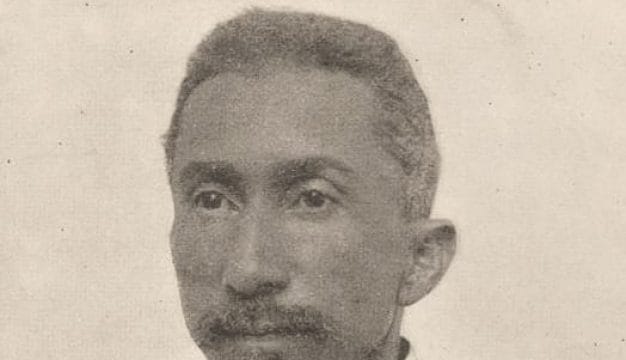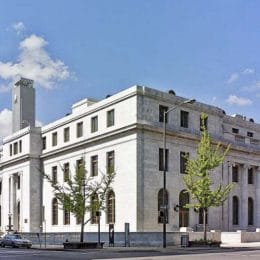Robert Smith Vance
Robert Smith Vance (1931-1989) was a circuit judge on the U.S. Court of Appeals for the Eleventh Circuit at the time of his assassination by a bomb mailed to his home in Mountain Brook, Jefferson County. He previously served on the U.S. Court of Appeals for the Fifth Circuit and had chaired the Alabama Democratic Party for many years, promoting racial equality in the party and on juries while in private practice.
Vance was born in Talladega, Talladega County, on May 10, 1931, to Harrell Taylor Vance Sr. and Mae Smith Vance. He was the youngest of four children. Vance spent his formative years in Birmingham, Jefferson County, and graduated from Woodlawn High School. Upon graduation, Vance attended the University of Alabama and received his bachelor’s degree in 1950. While there, he served as president of the Student Government Association. In 1952, he graduated with a law degree from the University of Alabama School of Law. Following law school, Vance joined the U.S. Army and became an attorney in the Judge Advocate General Corps in 1952. In 1953, Vance married Helen Rainey Vance, from Cullman, Cullman County, with whom he had two sons. In 1955, he completed a master of law degree from George Washington University.
During his military service, Vance assisted the U.S. Army’s legal team fight charges made by Wisconsin senator Joseph McCarthy that Communists had infiltrated the Army. The ensuing televised 1954 “Army-McCarthy Hearings” in Washington, D.C., resulted in negative publicity for McCarthy and his eventual censure in the Senate. Vance later served in the Army Reserve and retired as a lieutenant colonel. Vance returned to Alabama and served as a law clerk for Alabama Supreme Court justice James Mayfield from 1954 to 1956. For a brief time, he was an attorney for the U.S. Department of Labor before practicing law in Birmingham from 1956 until 1977. (Future governor Don Siegelman first practiced law in Vance’s firm.)
During his time in private practice, Vance was involved in civil rights causes, ranging from treating people equally in the courtroom to representing Black plaintiffs in legal suits. Likewise, Vance neither discriminated against Blacks who served as jurors, nor disqualify potential jurors because of their race. He also represented a plaintiff whose case was ultimately connected to the larger lawsuit that reached the U.S. Supreme Court as Reynolds v. Sims (1964). In it, the court ruled that state legislative districts should have equal populations based on the principle of “one person, one vote,” regardless of population differences.
Vance chaired the Alabama Democratic Party from 1966 to 1977 at a time when the state party brought more Black members into the organization. In doing so, Vance split with many southern Democrats by opposing segregation. His rise hurt Gov. George Wallace’s political faction, and Vance famously sparred against Wallace’s proposed delegates (which included noted segregationist Eugene “Bull” Connor) for the 1968 Democratic National Convention (DNC) to prevent it from being seated at the convention. Vance himself supported the Alabama Independent Democratic Party, which included among its leadership David Vann, a future mayor of Birmingham, and Joe L. Reed, then president of the predominantly Black Alabama State Teachers Association. Another anti-Wallace delegation was also formed, the National Democratic Party of Alabama led by Huntsville civil rights activist John L. Cashin Jr. Ultimately, the Vance delegation was seated at the convention and it included a large faction of Blacks as the first ever interracial delegation from Alabama at a DNC.
In 1977, Pres. Jimmy Carter nominated Vance to fill a vacancy on the U.S. Court of Appeals of the Fifth Circuit. Replacing Judge Walter Pettus Gewin, from Nanafalia, Marengo County, Vance was confirmed by the U.S. Senate on December 15, 1977, and was joined by noted Alabama judge Frank M. Johnson in 1979. Four years later, the states that comprised the Fifth Circuit were divided into two circuits beginning on October 1, 1981, and Vance would serve on the newly created U.S. Eleventh Circuit comprised of Alabama, Georgia, and Florida, again with Johnson.
On December 16, 1989, Vance was assassinated when a package delivered to his home exploded, killing him instantly. The mail bomb, which was reportedly marked as from a fellow judge, also seriously wounded his wife. He was buried at Saint Luke’s Episcopal Columbarium in Mountain Brook. At the time, Vance’s legal peers speculated the assassination was perhaps related to his legal work against international drug traffickers or adjudication of civil rights cases. But an investigator recognized the similarities between the bomb that detonated at the Vance home and a device seen 17 years previously. That clue led investigators to arrest Walter Leroy Moody Jr., who had been convicted for possession of that bomb. It was believed he assassinated Vance out of vengeance, but Vance was never directly linked to Moody’s case. Moody was charged with Vance’s murder, as well as the murder of civil rights attorney Robert E. Robinson, who was assassinated in Savannah, Georgia, two days later when a bomb exploded at his office. In federal court, Moody received seven life terms. At a state court in Alabama, the jury found him guilty of Vance’s murder and sentenced him to death in 1997. He was executed by lethal injection on April 19, 2018, at the age of 83.
In 1990, the federal government honored Vance by naming the federal building and courthouse in Birmingham the Robert S. Vance Federal Building and United States Courthouse. The Alabama Law Review dedicated part of its spring 1991 issue to Vance, featuring tributes from his eldest son, Robert Vance Jr., Frank Johnson, Howell Heflin, and others. His legal legacy continued with Vance Jr., who served as a state circuit judge in Birmingham. His wife, Joyce White Vance, was the U.S. Attorney for the North District of Alabama from 2009 until 2017 and has been a Distinguished Visiting Lecturer in Law at the University of Alabama and a contributor on the MSNBC news channel discussing legal issues.
Further Reading
- Jenkins, Ray. Blind Vengeance: The Roy Moody Mail Bomb Murders. Athens: University of Georgia Press, 2012.






